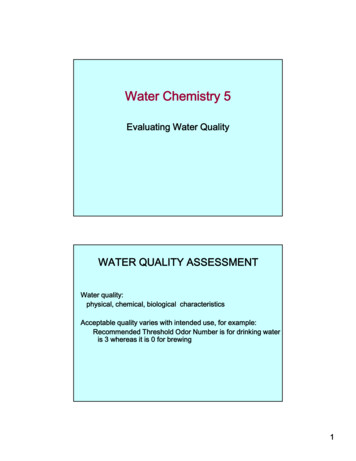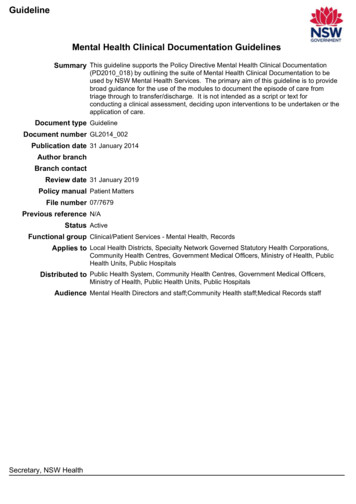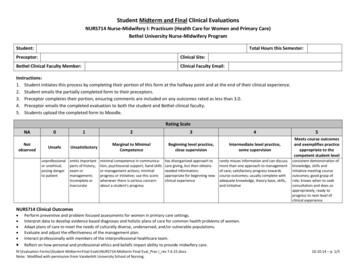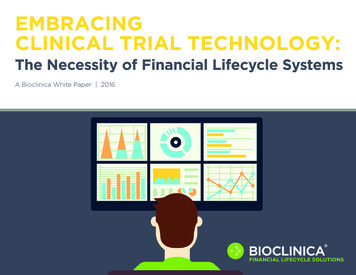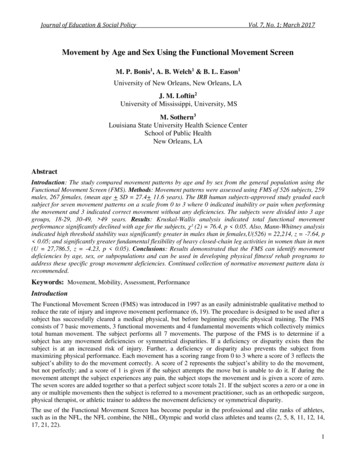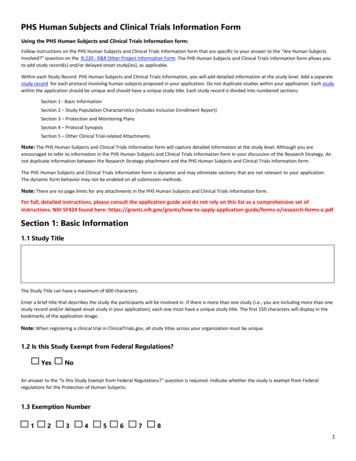
Transcription
PHS Human Subjects and Clinical Trials Information FormUsing the PHS Human Subjects and Clinical Trials Information form:Follow instructions on the PHS Human Subjects and Clinical Trials Information form that are specific to your answer to the “Are Human SubjectsInvolved?” question on the R.220 - R&R Other Project Information Form. The PHS Human Subjects and Clinical Trials Information form allows youto add study record(s) and/or delayed onset study(ies), as applicable.Within each Study Record: PHS Human Subjects and Clinical Trials Information, you will add detailed information at the study level. Add a separatestudy record for each protocol involving human subjects proposed in your application. Do not duplicate studies within your application. Each studywithin the application should be unique and should have a unique study title. Each study record is divided into numbered sections:Section 1 - Basic InformationSection 2 – Study Population Characteristics (includes Inclusion Enrollment Report)Section 3 – Protection and Monitoring PlansSection 4 – Protocol SynopsisSection 5 – Other Clinical Trial-related AttachmentsNote: The PHS Human Subjects and Clinical Trials Information form will capture detailed information at the study level. Although you areencouraged to refer to information in the PHS Human Subjects and Clinical Trials Information form in your discussion of the Research Strategy, donot duplicate information between the Research Strategy attachment and the PHS Human Subjects and Clinical Trials Information form.The PHS Human Subjects and Clinical Trials Information form is dynamic and may eliminate sections that are not relevant to your application.The dynamic form behavior may not be enabled on all submission methods.Note: There are no page limits for any attachments in the PHS Human Subjects and Clinical Trials Information form.For full, detailed instructions, please consult the application guide and do not rely on this list as a comprehensive set ofinstructions. NIH SF424 found here: tion-guide/forms-e/research-forms-e.pdfSection 1: Basic Information1.1 Study TitleThe Study Title can have a maximum of 600 characters.Enter a brief title that describes the study the participants will be involved in. If there is more than one study (i.e., you are including more than onestudy record and/or delayed onset study in your application), each one must have a unique study title. The first 150 characters will display in thebookmarks of the application image.Note: When registering a clinical trial in ClinicalTrials.gov, all study titles across your organization must be unique.1.2 Is this Study Exempt from Federal Regulations?YesNoAn answer to the “Is this Study Exempt from Federal Regulations?” question is required. Indicate whether the study is exempt from Federalregulations for the Protection of Human Subjects.1.3 Exemption Number123456781
The “Exemption Number” field is required if you selected “Yes” to the “Is this Study Exempt from Federal Regulations?” question. Select theappropriate exemption number(s) for this particular study. Multiple selections are permitted1.4 Clinical Trial Questionnaire1.4.a1.4.b1.4.c1.4.dDoes the study involve human participants? YesNoAre the participants prospectively assigned to an intervention? YesNoIs the study designed to evaluate the effect of the intervention on the participants? Yes NoIs the effect that will be evaluated a health-related biomedical or behavioral outcome? YesNoIf you answered “Yes” to all the questions in the Clinical Trial Questionnaire, this study meets the definition of a clinical trial.Refer to the table below for information about what sections of this form are required, based on your answers to Question 1.4 "Clinical TrialQuestionnaire."If you answered "yes" to all theIf you answered "no" to any ofquestions in the Clinical Trialthe questions in the Clinical TrialQuestionnaireQuestionnaireSection 2 - Study Population CharacteristicsRequiredRequiredSection 3 - Protection and Monitoring PlansRequiredRequiredSection 4 - Protocol SynopsisRequiredDo not completeForm SectionSection 5 - Other Clinical TrialrelatedAttachmentsRequired if specified in theFOADo not complete1.5 Clinical Trials.gov IdentifierIf a clinical trial has already been entered into ClinicalTrials.gov, enter the ClinicalTrials.gov identifier (e.g., NCT87654321) for this trial. If you arebuilding on an existing study (e.g., ancillary study), enter the ClinicalTrials.gov identifier only for the ancillary study, not the parent study.Section 2: Study Population Characteristics2.1 Conditions or Focus of StudyAt least 1 entry is required, and up to 20 entries are allowed. Each entry is limited to 255 characters.Identify the name(s) of the disease(s) or condition(s) you are studying, or the focus of the study. If available, use appropriate descriptors fromNLM's Medical Subject Headings (MeSH) so the application can be categorized. Include an entry for each condition.2.2 Eligibility CriteriaList the study’s inclusion and exclusion criteria. To provide a bulleted list, use a dash (or other character) followed by a space (“- “) at the start ofeach bullet. Be sure to check the formatting in the assembled application image. Further explanation or justification should be included in theRecruitment and Retention plan.2
Your text entry is limited to 15,000 characters.2.3 Age LimitsMinimum Age:YearsMonthsWeeksDaysHoursMinutesMaximum Age:YearsMonthsWeeksDaysHoursMinutes2.4 Inclusion of Women, Minorities, and ChildrenOrganize your attachment into two sections, following the headings and specified order below, and discuss each of the points listed below. Starteach section with the appropriate section heading – “Inclusion of Women and Minorities” and “Inclusion of Children.” Also include any additionalinformation requested in the FOA.**Attach this information as a PDF2.5 Recruitment and Retention PlanDescribe how you will recruit and retain participants in your study. You should address both planned recruitment activities as well as proposedengagement strategies for retention.**Attach this information as a PDF2.6 Recruitment StatusSelect a single "Recruitment Status" that best describes the proposed study, based upon the status of the individual sites. If any facility in a multisite study has an individual site status of “recruiting,” then choose “recruiting” for this question. Only one selection is allowed. Choose from thefollowing options:Not yet recruitingRecruitingEnrolling by invitationActive, not recruitingCompletedSuspendedTerminated (Halted Prematurely)Withdrawn (No Participants Enrolled)2.7 Study TimeLineProvide a description or diagram describing the study timeline. The timeline should be general (e.g., "one year after notice of award"), and shouldnot include specific dates.**Attach this information as a PDF2.8 Enrollment of First SubjectEnter the date (MM/DD/YYYY) of the enrollment of the first subject into the study. From the dropdown menu, select whether this date isanticipated or actual.Date:AnticipatedActual*Choose One3
Inclusion Enrollment Report(s) Required for all human subject studies, unless exemption 4. *Inclusion Report on last page*Section 3: Protection and Monitoring Plans3.1 Protection of Human SubjectsDetailed Instructions for the Protection of Human Subjects document can be found in the NIH SF424 HEREDo not use the “Protection of Human Subjects” attachment to circumvent the page limits of the Research Strategy.For Human Subjects Research Claiming Exemptions: If you are claiming that your human subjects research falls under any exemptions, justify whythe research meets the criteria for the exemption(s) that you have claimed. This justification should explain how the proposed research meetsthe criteria for the exemption claimed. Do not merely repeat the criteria or definitions themselves.For Studies that involve Non-Exempt Human Subjects Research: For any proposed nonexempt study involving human subjects, NIH requires aProtection of Human Subjects attachment that is commensurate with the risks of the study, its size, and its complexity. Organize your attachmentinto four sections, following the headings and specified order below, and discuss each of the points listed below. Start each section with theappropriate section heading – Risks to Human Subjects, Adequacy of Protection Against Risks, Potential Benefits of the Proposed Research toResearch Participants and Others, and Importance of the Knowledge to be Gained. Also include any additional information requested in the FOA.**Attach this information as a PDF3.2 Is this a multi-site study that will use the same protocol to conduct non-exempt human subject’sresearch at more than on domestic site?YesNo*If “Yes” you must include a single IRB plan3.3 Data and Safety Monitoring PlanA “Data and Safety Monitoring Plan” attachment is required if you answered “Yes” to all the questions in the “Clinical Trial Questionnaire.” The “Dataand Safety Monitoring Plan” attachment is optional for all other human subjects research.For human subjects research that does not involve a clinical trial: Your study, although it is not a clinical trial, may have significant risksto participants, and it may be appropriate to include a data and safety monitoring plan. If you choose to include a data and safety monitoring plan,you may follow the content criteria listed below, as appropriate.For any proposed clinical trial, NIH requires a data and safety monitoring plan (DSMP) that is commensurate with the risks of the trial, its size, andits complexity. Provide a description of the DSMP, including: The overall framework for safety monitoring and what information will be monitored. The frequency of monitoring, including any plans for interim analysis and stopping rules (if applicable). The process by which Adverse Events (AEs), including Serious Adverse Events (SAEs) such as deaths, hospitalizations, and life threateningevents and Unanticipated Problems (UPs), will be managed and reported, as required, to the IRB, the person or group responsible formonitoring, the awarding IC, the NIH Office of Biotechnology Activities, and the Food and Drug Administration. The individual(s) or group that will be responsible for trial monitoring and advising the appointing entity. Because the DSMP will dependon potential risks, complexity, and the nature of the trial, a number of options for monitoring are possible. These include, but are notlimited to, monitoring by a: PD/PI: While the PD/PI must ensure that the trial is conducted according to the approved protocol, in some cases (e.g., low risk trials, notblinded), it may be acceptable for the PD/PI to also be responsible for carrying out the DSMP. Independent safety monitor/designated medical monitor: a physician or other expert who is independent of the study. Independent Monitoring Committee or Safety Monitoring Committee: a small group of independent experts. Data and Safety Monitoring Board (DSMB): a formal independent board of experts including investigators and biostatisticians. NIHrequires the establishment of DSMBs for multi-site clinical trials involving interventions that entail potential risk to the participants, andgenerally, for all Phase III clinical trials, although Phase I and Phase II clinical trials may also need DSMBs. If a DSMB is used, pleasedescribe the general composition of the Board without naming specific individuals.**Attach this information as a PDF3.4 Will a Data and Safety Monitoring Board be appointed for this study?YesNo3.5 Overall Structure of the Study Team4
Provide a brief overview of the organizational structure of the study team, particularly the administrative sites, data coordinating sites,enrollment/participating sites, and any separate laboratory or testing centers.**Attach this information as a PDFSection 4: Protocol Synopsis - NOT REQUIRED; NOT CLINICAL TRIAL4.1 Brief SummaryEnter a brief description of objectives of the protocol, including the primary and secondary endpoints. The Brief Summary is limited to5,000 characters.4.2 Study Design4.2.a Narrative Study DescriptionEnter a narrative description of the protocol. Studies differ considerably in the methods used to assign participants and deliver interventions.Describe your plans for assignment of participants and delivery of interventions. You will also need to show that your methods for sample sizeand data analysis are appropriate given those plans. For trials that randomize groups or deliver interventions to groups, special methods arerequired; additional information is available at the Research Methods Resources webpage.The narrative description is limited to 32,000 characters.4.2.b Primary PurposeEnter or select from the dropdown menu a single "Primary Purpose" that best describes the clinical trial. Choose from the following options:TreatmentPreventionDiagnosticsSupportive CareScreeningHealth Services ResearchBasic ScienceDevice FeasibilityOther (If you select “Other,” provide a description in the space provided. Your response is limited to 255 characters.)4.2.cInterventionsComplete the “Interventions” fields for each intervention to be used in your proposed protocol. If an arm of the study to which subjects will beassigned (as discussed in 4.2.a. Narrative Study Description) includes more than one intervention (e.g., drug plus educational intervention),complete this section for each intervention. You can add up to 20 interventions.Intervention Type: Enter or select from the dropdown menu the intervention type the clinical trial will administer during the proposed award.Choose from the following options:Drug (including placebo)Device (including sham)5
oral (e.g., Psychotherapy, Lifestyle Counseling)Genetic (including gene transfer, stem cell, and recombinant DNA)Dietary Supplement (e.g., vitamins, minerals)Combination ProductDiagnostic TestOtherName: Enter the name of the intervention. The name must be unique within each study record. The name is limited to 200 characters.Description: Enter a description of the intervention. The description is limited to 1,000 characters.4.2.d Study PhaseEarly Phase 1 (or Phase 0)Phase 1Phase 1/2Phase 2Phase 2/3Phase 3Phase 4Other (If you select “Other,” provide a description in the space provided. Your response is limited to 255 characters.)Is this an NIH-defined Phase III clinical trial? YesNo4.2.eIntervention ModelSingle GroupParallelCross-OverFactorialSequentialOther (If you select “Other,” provide a description in the space provided. Your response is limited to 255 characters.)4.2.fMaskingYesNoSelect "Yes" or "No" to indicate whether the protocol uses masking. Note that masking is also referred to as “blinding.”If “Yes” choose from the following options:ParticipantCare ProviderInvestigatorOutcomes Assessor4.2.g AllocationN/ARandomizedNon-randomized4.3 Outcome Measures6
You may have more than one primary outcome measure, and you can add up to 50 outcome measures.Name:Type:Primary – select this option for the outcome measures specified in your protocol that are of greatest importance to your studySecondary – select this option for outcome measures specified in your protocol that are of lesser importance to your study than yourprimary outcomesOther – select this option for additional key outcome measures used to evaluate the intervention.Time Frame: (Indicate when a measure will be collected for analysis (e.g., baseline, posttreatment).)Brief Description: (Describe the metric used to characterize the outcome measure if the metric is not already included in the outcome measurename. Your description is limited to 999 characters.)4.4 Statistical Design and PowerSpecify the number of subjects you expect to enroll, the expected effect size, the power, and the statistical methods you will use with respect toeach outcome measure you listed in 4.3 Outcome Measures.You will need to show that your methods for sample size and data analysis are appropriate given your plans for assignment of participants anddelivery of interventions. For trials that randomize groups or deliver interventions to groups, special methods are required; additional informationis available at the Research Methods Resources webpage.**Attach this information as a PDF4.5 Subject Participation Duration (Enter the time (e.g., in months) it will take for each individual participant to complete all studyvisits. If the participation duration is unknown or not applicable, write “unknown” or “not applicable.” The subject participation duration islimited to 255 characters.)4.6 Will the study use an FDA-regulated intervention YesNo4.6.a If yes, describe the availability of Investigation Product (IP) and Investigation New Drug(IND)/Investigational Device Exemption (IDE) statusDescribe the availability of study agents and support for the acquisition and administration of the study agent(s). Please indicate theIND/IDE status of the study agent, if applicable, and whether the investigators have had any interactions with the FDA. If the studyagent currently has an IND/IDE number, provide that information. Note: The awarding component may request consultation withthe FDA and the IND/IDE sponsor about the proposed clinical trial after peer review and prior to award.**Attach this information as a PDF4.7 Dissemination PlanExplain briefly your plan for the dissemination of NIH-funded clinical trial information and address how the expectations of the policy will be met.The plan must contain sufficient information to assure the following: the applicant will ensure that clinical trial(s) under the award are registered and results information is submitted to ClinicalTrials.gov asoutlined in the policy and according to the specific timelines stated in the policy; informed consent documents for the clinical trial(s) will include a specific statement relating to posting of clinical trial information atClinicalTrials.gov; and the recipient institution has an internal policy in place to ensure that clinical trials registration and results reporting occur in compliancewith policy requirements. Note: Do not include informed consent documents in your application.Note: If your human subjects study meets the definition of “Delayed Onset,” include the dissemination plan in the delayed onset study justification.**Attach this information as a PDF7
Section 5: Other Clinical Trial-related Attachments - NOT REQUIRED; NOTCLINICAL TRIALIf you answered “Yes” to all the questions in the “Clinical Trial Questionnaire:” Include an attachment only if your FOA specifies thatan attachment(s) is required or permitted; otherwise, do not include any Other Clinical Trial-related attachments.If you answered “No” to any question in the “Clinical Trial Questionnaire:” Do not provide information in this section. Inputting information inthis section will result in errors and will prevent your application from being accepted.Document Created by Department of Internal Research Admin; Contact Jessica Little [jessica.little@hsc.utah.edu] with questionsand/or comments8
Inclusion Enrollment ReportThis report format should NOT be used for collecting data from study participants.Study Title(must beunique):1.Using an Existing Dataset or Resource:YesNo2.Enrollment Location Type:DomesticForeign3.Enrollment Country(ies):4.Enrollment Location(s):5.Comments:PlannedRacial CategoriesEthnic CategoriesNot Hispanic or LatinoFemaleAmerican Indian/ AlaskaNativeAsianNative Hawaiian or Other PacificIslanderBlack or African AmericanWhiteMore than One RaceTotalMaleHispanic or LatinoFemaleMaleTotalTotal
ActualRacial CategoriesEthnic CategoriesNot Hispanic or LatinoFemaleAmerican Indian/ AlaskaNativeAsianNative Hawaiian or Other PacificIslanderBlack or African AmericanWhiteMore than One RaceTotalMaleHispanic or LatinoFemaleMaleTotalTotal
If you answered “Yes” to all the questions in the Clinical Trial Questionnaire, this study meets the definition of a clinical trial. . **Attach this information as a PDF 2.6 Recruitment Status . Data and Safety Monitoring Board (DSMB): a formal independent board of expe
